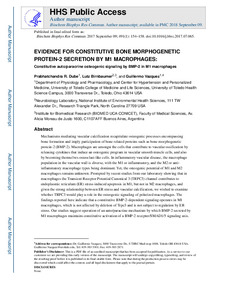Por favor, use este identificador para citar o enlazar este ítem:
https://repositorio.uca.edu.ar/handle/123456789/8723| Título: | Evidence for constitutive bone morphogenetic protein-2 secretion by M1 macrophages: constitutive auto/paracrine osteogenic signaling by BMP-2 in M1 macrophages | Autor: | Dube, Prabhatchandra R. Birnbaumer, Lutz Vazquez, Guillermo |
Palabras clave: | CALCIFICACION; OSTEOGENESIS; ENFERMEDADES VASCULARES | Fecha de publicación: | 2017 | Editorial: | Elsevier | Cita: | Dube PR, Birnbaumer L, Vazquez G. Evidence for constitutive bone morphogenetic protein-2 secretion by M1 macrophages: constitutive auto/paracrine osteogenic signaling by BMP-2 in M1 macrophages [en línea]. Biochemical and Biophysical Research Communications. 2017;491(1):154-158. doi:10.1016/j.bbrc.2017.07.065 Disponible en: https://repositorio.uca.edu.ar/handle/123456789/8723 | Resumen: | Abstract: Mechanisms mediating vascular calcification recapitulate osteogenic processes encompassing bone formation and imply participation of bone related proteins such as bone morphogenetic protein-2 (BMP-2). Macrophages are amongst the cells that contribute to vascular ossification by releasing cytokines that induce an osteogenic program in vascular smooth muscle cells, and also by becoming themselves osteoclast-like cells. In inflammatory vascular disease, the macrophage population in the vascular wall is diverse, with the M1 or inflammatory, and the M2 or anti-inflammatory macrophage types being dominant. Yet, the osteogenic potential of M1 and M2 macrophages remains unknown. Prompted by recent studies from our laboratory showing that in macrophages the Transient Receptor Potential Canonical 3 (TRPC3) channel contributes to endoplasmic reticulum (ER) stress-induced apoptosis in M1, but not in M2 macrophages, and given the strong relationship between ER stress and vascular calcification, we wished to examine whether TRPC3 would play a role in the osteogenic signaling of polarized macrophages. The findings reported here indicate that a constitutive BMP-2-dependent signaling operates in M1 macrophages, which is not affected by deletion of Trpc3 and is not subject to regulation by ER stress. Our studies suggest operation of an auto/paracrine mechanism by which BMP-2 secreted by M1 macrophages maintains constitutive activation of a BMP-2 receptor/SMAD1/5 signaling axis. | URI: | https://repositorio.uca.edu.ar/handle/123456789/8723 | ISSN: | 0006-291X 1090-2104 (online) |
Disciplina: | MEDICINA | DOI: | 10.1016/j.bbrc.2017.07.065 | Derechos: | Acceso Abierto | Fuente: | Biochemical and Biophysical Research Communications. 2017;491(1):154-158 |
| Aparece en las colecciones: | Artículos |
Ficheros en este ítem:
| Fichero | Descripción | Tamaño | Formato | |
|---|---|---|---|---|
| evidence-constitutive-bone-morphogenetic.pdf | 485,47 kB | Adobe PDF |  Visualizar/Abrir |
Visualizaciones de página(s)
286
comprobado en 22-dic-2025
Descarga(s)
211
comprobado en 22-dic-2025
Google ScholarTM
Ver en Google Scholar
Altmetric
Altmetric
Este ítem está sujeto a una Licencia Creative Commons

